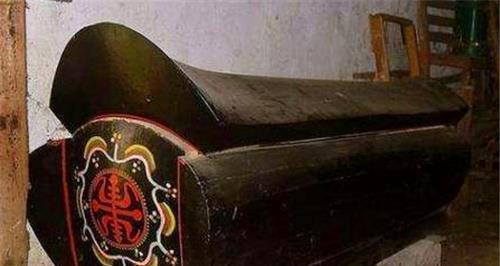In the past, in rural areas, people would prepare coffins before they died, but it was taboo to call them "coffins" and "shou materials". Usually things related to "death" will have many taboos, because "death" is a very unlucky thing, so everyone will try to be auspicious and avoid these things.

In 2005, in a rural area of Henan, a farmer planned to build a new house because his son got married, and the marriage was a festive thing, so the family was very happy, and other villagers would come to help, but when laying the foundation, they accidentally dug out a "blood coffin".
The blood coffin looks very strange, it feels like the coffin is a long time away, but the blood on it seems to be new, and there is a bronze mirror in the middle of the blood coffin, which is very scary.
So some of the villagers who came over said that the dead buried here had become ghosts, and it was better to deal with them earlier. Usually, in order to prevent the reincarnation of the ancestors, some unworthy descendants are buried in a "blood coffin", so that the fortunes of the descendants will be strong.
There are also some bold villagers who think that there should be good treasures in the coffin, and that such a coffin is only made to scare away the tomb robbers.
The farmer felt that it was very obscure to encounter a "blood coffin" on a happy day, so he did not think much about it and burned the coffin. However, the disappearance of the "blood coffin" in the village did not go away, and it reached the ears of some experts, so the experts rushed to come.
Later, the archaeological team excavated and found that this is actually an ancient tomb belonging to the Qing Dynasty, and some cultural relics have been excavated, and from the excavated cultural relics, the identity of the tomb owner should be very noble. When the experts learned that the "blood coffin" had been burned, they were also very sorry and told the villagers: "Their value exceeds 500 million." ”
The coffin should have been made entirely of the finest gold silk wood, but it had been destroyed at this point.
Although China has implemented the Law of the People's Republic of China on the Protection of Cultural Relics since November 19, 1982 in order to strengthen the protection of cultural relics, because remote areas still believe in superstitious claims and have little understanding of cultural relics, coffins are things that contain dead people, just feel obscure, and will not think about protecting it.
After passing through this incident, people also felt that the work of protecting cultural relics had a long way to go, and later the knowledge of cultural relics was gradually popularized, and people paid more and more attention to cultural relics. Since 2007, China has also implemented the Law on the Protection of Cultural Relics of China, which stipulates that no unit or individual can excavate cultural relics buried underground without permission.
In addition, the red coffin is called "Coffin Guo", and the Yi ZhiXia says: "The burial of the ancients, the thick clothes of the salary, the burial of the middle field, the unsealed tree, the mourning period is innumerable." Later generations of saints will easily use coffins to cover all the great transgressions. ”
In ancient times, what the coffin looks like, can also indicate the identity and rank of the deceased, in the Zhou Dynasty period there are regulations, the coffin of the Son of Heaven is four-fold, the innermost is called "rafter", the second coffin is called "earth", the third coffin is called "genus", the fourth is called "large coffin", "the empress dowager outside the rafters are double, mostly using catalpa wood, so its coffin is also called 'Zi Palace'".
The coffin of the Shanggong is three-fold, the coffin of Hou Bozi is two-fold, the coffin of the doctor is one-fold, and the coffin of the Shu people is thick and four-storing, and there is no rafter, and the emperors, nobles, and scholars during the feudal dynasty basically follow this system.
According to the General Code. The 45th Book of Rites records: "The weekly system ... Junli coffin is made of vermilion green and miscellaneous gold; the coffin of the doctor is made of dark green and ox bones; and the soldier is not green. "In addition, in ancient times, the coffin was hung with a bronze mirror, and the ancients believed that it had the effect of guiding the way and warding off evil spirits.